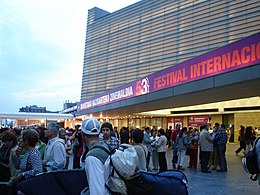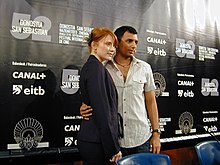San Sebastián International Film Festival
 The Kursaal during the 53rd edition | |
| Location | Donostia-San Sebastián, Basque Country, Spain |
|---|---|
| Founded | 1953 |
| Most recent | 2023 |
| Awards | Golden Shell, Silver Shells, Donostia Award, Sebastiane Award |
| Hosted by | Festival Internacional de Cine de Donostia-San Sebastián, Sociedad Anónima |
| No. of films | 200–250 |
| Language | International |
| Website | sansebastianfestival |
The San Sebastián International Film Festival (abbr. SSIFF; Spanish: Festival Internacional de San Sebastián, Basque: Donostia Zinemaldia) is an annual FIAPF A category film festival held in the Spanish city of Donostia-San Sebastián in September, in the Basque Country.[1][2]
Since its creation in 1953 it has established itself as one of the 14 "A" category competitive festivals accredited by the FIAPF, of which it has one of the lowest budgets. It has hosted several important events of the history of cinema, such as the international premieres of Vertigo, by Alfred Hitchcock (who attended the Festival) and the European premiere of Star Wars. It was the first festival attended by Roman Polanski and has helped advance the professional careers of filmmakers such as Francis Ford Coppola, Bong Joon-ho and Pedro Almodóvar.[citation needed]
José Luis Rebordinos has served as the director of the festival since 2011.[3]
History
The festival was founded on September 21, 1953.[4] Non-Spanish language films became eligible for consideration in 1955[citation needed], when the festival was specialized in color films. It has been acknowledged by the FIAPF as an A category festival since 1957, with the exception of the 1980–1984 period, when no major awards were given.
SSIFF has hosted the European premiere of Star Wars, the international premiere of Vertigo, presented by Alfred Hitchcock and Roman Polanski's first attendance at a film festival.[5]
Sections



These are the main sections of the festival:
- Official Selection: a selection of recent full-length cinematographic works, which have not previously screened in other festivals (except FIAPF-regulated non-competitive festivals and national competitions at festivals in their countries of production), compete for the major awards. Spanish-produced films in competition must be world premieres.[6] Some films are included out of competition.
- New Directors: First or second movies of new talents.
- Horizontes Latinos: A selection of films from Latin America, unreleased in Spain.
- Pearls: A selection of the best movies screened at other international festivals throughout the year.
- Zabaltegi – Tabakalera: A competitive section aiming for heterogeneity with no formal norms.
- Made in Spain: A showcase of the year's Spanish movies for their international launch.
- Zinemira: A showcase of movies produced or directed by Basques.
- Retrospectives: Retrospectives are included in the program to present the works of a renowned filmmaker or works that represent a particular theme.
- Culinary Cinema: A non-competitive selection of gastronomy-related films.
- Velodrome: Projections of movies for a big audience in a giant screen installed at the Velódromo de Anoeta.
- Nest Film Students: Selected shorts, mostly graduation projects, from film schools around the world.
Awards
An international jury evaluates the films in the Official Selection and awards the following prizes:
- Golden Shell for Best Film
- Special Jury Prize
- Silver Shell for Best Leading Performance (since 2021)
- Silver Shell for Best Supporting Performance (since 2021)
- Silver Shell for Best Director
- Jury Prize for Best Cinematography
- Jury Prize for Best Screenplay
- Donostia Award
Former awards include:
- Silver Shell for Best Actress (1953–2020) (replaced by Best Leading Performance and Best Supporting Performance)
- Silver Shell for Best Actor (1953–2020) (replaced by Best Leading Performance and Best Supporting Performance)
The following are the main awards for films in the parallel sections:
- New Directors Award: decided by a special jury, the films in the New Directors section compete for this prize.
- Audience Award: The audience chooses a film from among those in the Pearls section.
- Youth Award: A jury composed of 350 youngsters aged between 17 and 21 chooses a film from those competing for the "New Directors Award".
- Horizontes Award: A specific jury chooses the best film in the Horizontes Latinos section.
- "Otra Mirada" Award: TVE gives the Another Look award to the film, from any section, that best reflects the female world.
- Sebastiane Award: a jury chooses the film, from any section, that best reflects the values and reality of lesbians, gays, bisexuals and transgender people.
References
- ^ "San Sebastian International Film Festival". FilmFestivalLife.com. Archived from the original on 20 September 2017. Retrieved 9 May 2018.
- ^ Cox, David (24 September 2012). "San Sebastián keeps one eye on profits with Arbitrage premiere". The Guardian. ISSN 0261-3077. Retrieved 31 July 2019.
- ^ Ezquiaga, Mitxel (28 September 2017). "¿Quiénes mandan en el festival?". Diario Vasco. Archived from the original on 30 August 2024.
- ^ "Background details". San Sebastian Festival. Archived from the original on 5 March 2021. Retrieved 5 July 2020.
- ^ Samuels, A. J. (9 November 2012). "San Sebastian International Film Festival: 60 Years of Cinema and Beyond". Culture Trip. Archived from the original on 8 May 2022. Retrieved 8 May 2022.
- ^ "Reglamento Sección Oficial. 70 edición - 2022". San Sebastián Festival. Archived from the original on 1 October 2022. Retrieved 31 July 2022.
